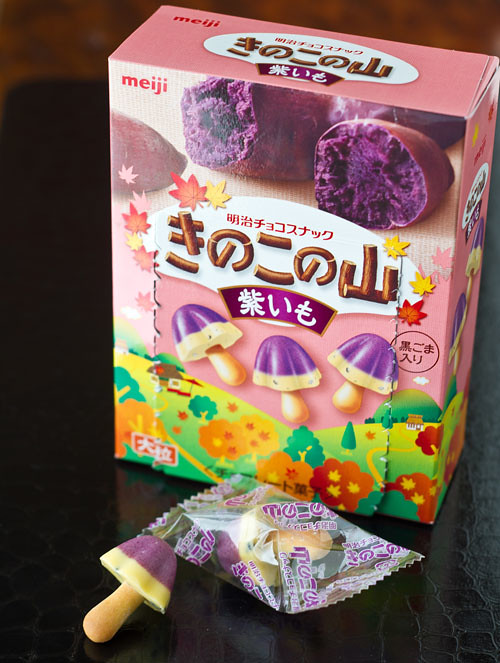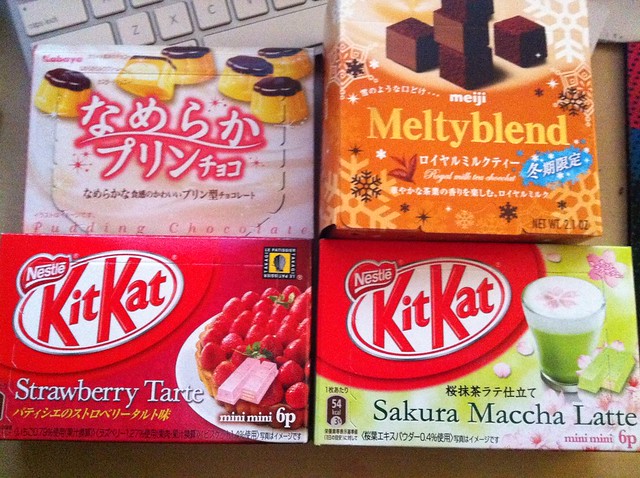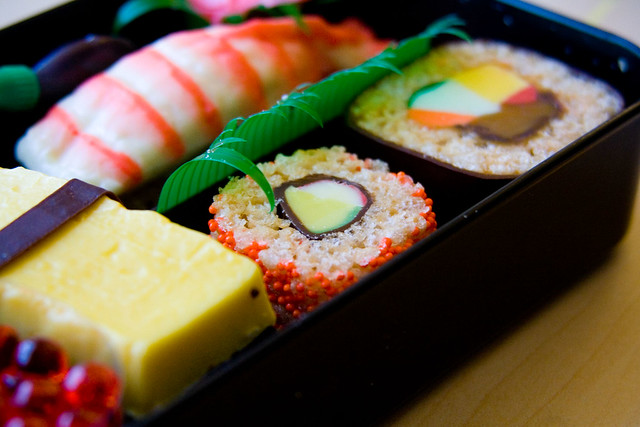Podcast: Play in new window | Download (Duration: 26:23 — 24.2MB)
This week, Rachael and Allison have learned that… they just can’t get away from those purple sweet potato mountain mushroom candies. Addicted? Yes, we are.

Hey look, it’s the purple sweet potato mountain mushrooms again! (Yeah, we’re kind of obsessed.)
But really, this week we’re talking about chocolate! Or, as they say in Japan, chokorēto (チョコレート), which is often abbreviated to just choco (チョコ).
In Japan the big chocolate season starts on Valentine’s Day and goes to White Day (March 14).
The first Valentine’s Day ad in Japan appeared in 1936, but then WWII happened. A department store manager attempted to promote a Western-style Valentine’s Day chocolate sale in 1958 (chocolate was supposedly introduced to the Japanese during WWII, where it was provided as a ration for the US military), but only sold fives boxes of chocolates. It wasn’t until the Japanese chocolate company Morinaga decided to promote Valentine’s Day in the 1970s as a day for women to give chocolate to men and confess their love that Valentine’s Days stuck.
Although the Japanese are late-comers to the chocolate scene, they are taking the chocolate world it seems by storm. At the 17th Salon du Chocolate held in Paris last October, the Japanese chocolate makers and pastry chefs were the stars. One of them, Susumu Koyama, 47, was named “Best Foreign Chocolatier” – winning out over top masters from celebrated chocolate-making nations like Belgium and Switzerland.
Valentine’s Day in Japan is a bit different than in the US. Women give men gifts of chocolate, as well as other gifts. (We’re still not sure if we approve of this rule.) There are three categories of chocolate given for Valentine’s Day:
- giri choco (obligatory chocolate) (義理チョコ)
- this is chocolate given by women to people like bosses, coworkers, male friends, etc.
- usually small, inexpensive boxes of chocolate
- it’s not unusual for a woman to buy 20 to 30 boxes of this type of chocolate for distribution around the office
- there’s also something called “cho-giri-choco” (ultra-obligatory chocolate) which given to unpopular people you REALLY don’t want to give chocolate to
- honmei choco (“favorite chocolate”) (本命チョコ)
- this is the kind of chocolate women give to the one they want to express their love to (their husband, boyfriend, or person they have a crush on)
- these tend to be more expensive, maybe even homemade
- tomo choco (“friend chocolate”) (友チョコ)
- fairly recent development over the past few years
- these are chocolates a woman gives to her female friends
- usually something in the medium price range that the woman would enjoy eating herself… it’s also becoming popular to make homemade treats
Just for you guys… we made these tomo choco candy wrappers that you can download and wrap around the chocolate you give to your friends! CLICK HERE TO DOWNLOAD.

tako no tomo choco (octopus friend chocolate)

anata wa watashi no tomodachi desu (you are my friend)

yoi chokoreto (good chocolate)

tako no ai (octopus love)
On March 14th, it’s White Day – the men’s turn to give chocolate back to the women who gifted them chocolate on Valentine’s Day. This is known as okaeshi (a gift in return) and generally consists of marshmallows, chocolate, cookies or cakes. White Day made it’s first appearance after June of 1979, when the All Japan Sweets and Confectionary Makers Union met and decided to implement a White Day campaign in 1981, as a day for men to give okaeshi for the gifts given on Valentine’s Day.
If it strikes your fancy, how about a chocolate bath for Valentine’s Day? Every year for Valentine’s Day, the Hakone Kowakien Yunessun (a spa resort), outside of Tokyo, hosts a chocolate bath, where you can soak in a large pool of warm melted chocolate. (There are all sorts of fun special events happening in Japan for Valentine’s Day!)
We sampled a few more types of chocolate this week… Allison got a couple more flavors of Kit Kats – Strawberry Tarte and Sakura Maccha Latte, a Royal Milk Tea-flavored Meltyblend, and something called Pudding Chocolate. Rachael also got some Meltys (hers were plain chocolate) and some Milk Chocolate Sea Salt-flavored Pocky. All delicious.

Japanese flavors are starting to make their way into the artisan chocolate world. For example, Vosges in New York has an “Asian Take-Out Collection” which includes a Japanese-inspired truffle with ginger, wasabi, dark chocolate, and black sesame seeds. Kee’s Chocolates, also in New York, makes flavors such as black sesame, green tea, ginger, and yuzu.
We’ve also seen chocolate-covered edamame, Southeast Asian flavors (which are delicious – Allison had a chance to try them a while ago), and even chocolate sushi (though we’re very sad to report they have unfortunately closed in the years since Allison got to try them).

What we’d really like to see are some chocolate onigiri. We were thinking it might be interesting to make a chocolate-dipped onigiri… but Rachael really wants an onigiri-shaped chocolate mold. Can anyone make one for us? We’ll give you an honorary Uni-versity degree…
And hey, we’ve been interviewed! We got to talk with our friend SushiPRO, and he posted Part 1 and Part 2 on his blog last week.
So we want to know… are you planning on giving any chocolate (tomo choco, perhaps, or maybe even some honmei choco?) this Valentine’s Day?
